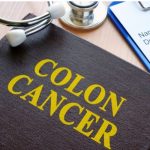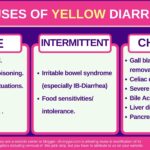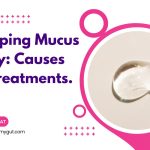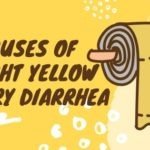5 Causes of Painless Bright Red Blood in Stool & When to Worry.
Our content is not intended nor recommended as a substitute for medical advice by your doctor. Use for informational purposes only.
What you need to know:
- Bright red blood in the stool is often due to bleeding from the last part of the colon (sigmoid and descending colon) or the rectum.
- Hemorrhoids are the most common cause (in more than 95% of cases) of painless, bright red blood in the stool.
- Diverticular disease is another common disease that causes occasional bleeding; It often affects the sigmoid colon.
- Other less common causes of PAINLESS bleeding include colorectal cancer, a large polyp at the rectum or sigmoid colon, rectal ulcer, or inflammatory bowel disease.
- Painful rectal bleeding is commonly due to anal fissures, proctitis, anal abscess or fistula, and dysentery.
- See a doctor if you have significant or recurrent bright red blood in the stool or if you have risk factors for diverticular disease or colon cancer.
1 . Hemorrhoids (the most common cause of painless, bright red blood in stool).
Hemorrhoids are the most common cause of bright red blood in stool with no pain. They are dilated and swollen veins in the wall of the anal canal and/or the rectum.
How common are hemorrhoids and hemorrhoidal bleeding?
- Hemorrhoids are widespread. In a large study in the USA, the overall prevalence of hemorrhoids is about 4.4% of the general population.
- Hemorrhoids affect both men and women equally.
- The commonest age for getting hemorrhoids is between 45 and 65.
- Hemorrhoids are rare below the age of 20.
Causes of hemorrhoids.
Hemorrhoids increase with age due to deterioration of the connective tissues holding the hemorrhoidal veins in place.
Several risk factors are linked to hemorrhoids, such as:
- Advancing age.
- Pregnancy.
- Chronic constipation.
- Chronic diarrhea.
- Chronic anal sphincter spasm and straining.
- Pelvic tumors.
- Prolonged sitting.
- Patients receive anticoagulation and anti-platelet therapy (like people with heart diseases).
Symptoms:
- Asymptomatic (40%): many people may have hemorrhoids without symptoms. Bright red blood in stool with no pain can be the first presentation.
- The bright red blood can take several forms:
– Frank is bleeding bright red blood without a stool.
– Bright red blood when you wipe.
– bright red blood mixed with the stool.
– Red spots on the stool.
– Bright red staining of the toilet water. - Bleeding is Painless in most cases. Painful hemorrhoidal bleeding occurs only when the piles are thrombosed and inflamed.
- Anemia (uncommon): due to frequent minute bleeding or an attack of massive painless bleeding per rectum. Symptoms of anemia include easy fatigue, shortness of breath on exertion, fast heartbeats, headaches, and dizziness.
- There is a sense of Fullness in the anal canal (due to prolapsed anal hemorrhoids).
- Palpapale lump or skin tag in the anal opening (due to a prolapsed thrombosed vein).
- Itching or irritation in the skin around the anus.
- Mild soiling accidents (fecal incontinence).
- Mucus discharge and wetness around the anus.
- Inflamed thrombosed veins may cause extreme anal pain (and may cause painful blood in the stool).
Grades:
There are two main types of hemorrhoids:
- Internal hemorrhoids: deeper inside the anal canal and the rectum. They are more likely to cause painless bleeding.
- External hemorrhoids: are under the skin around your anus. They are more likely to cause pain and irritation.
There is no widely used grading system for hemorrhoids. However, internal hemorrhoids are graded according to the degree of prolapse (reference):
- GRADE I: No prolapse (only seen with a unique anoscopy tool).
- GRADE II: The hemorrhoids prolapse outside the anal canal but reduce spontaneously.
- GRADE III: They prolapse but need manual reduction (don’t reduce spontaneously).
- GRADE IV: Irreducible hemorrhoids.
When to see a doctor for hemorrhoidal bleeding:
Your doctor should evaluate any case of painless anal bleeding. Seeing a doctor is a must when there are:
- Massive bright red blood in the stool.
- Frequent minor bleeding every time you poop.
- Symptoms of anemia (fatigue, shortness of breath, fast heartbeats, dizziness, etc.).
- Chronic constipation or diarrhea.
- Development of severe pain in the anal area.
- Prolapsed hemorrhoids cannot be reduced.
Treatment & Prevention:
- Eat a high-fiber diet: fibers add a build to your stool, preventing the hardening of the poop and constipation. For example, eat more fruits, vegetables, and whole grains.
- Fiber supplements or laxatives may also help if you have chronic constipation.
- Avoid excessive straining.
- If bleeding is massive or doesn’t stop, seek emergency medical help.
- Topical treatments containing analgesic (local anesthetic) and anti-inflammatory agents (steroids) may also help.
NOTE: Don’t use over-the-counter steroid creams for more than a week without permission from your doctor. - Soaking your anal area in warm water for 10-15 minutes may also help.
- Intervention: Inflammed or bleeding hemorrhoids may need intervention. Multiple procedures can help with hemorrhoidal bleeding:
– Rubber band ligation of the dilated veins.
– Injection (sclerotherapy): a chemical substance is injected to shrink the hemorrhoidal vein.
– Coagulation (using infrared, laser, or bipolar devices).
– Hemorrhoid removal surgery (hemorrhoidectomy).
– Hemorrhoid stapling (blocking the blood supply to the hemorrhoid veins.
2. Diverticular disease.
Diverticulae are sac-like projections arising from weak areas of the colon. The most common site of diverticula is the sigmoid colon (the last part of the colon just before the rectum).

Diverticular disease is very common, and its incidence increases with age. For example, over 60% of people above 60 have colon diverticula.
About 5 to 10% of people with diverticular disease may experience bright red blood in the stool with no pain.
The cause of the diverticular disease is not fully understood.
Pain occurs only when there is diverticular inflammation (diverticulitis). The most common site for diverticulitis pain is the lower-left abdomen (the site of the sigmoid colon).
Symptoms suggestive of diverticular bleeding:
- Being older is a risk factor for diverticulitis.
- The lack of symptoms of hemorrhoids, such as the sense of prolapsed mass or Fullness in the rectum, increases the probability of having diverticulitis.
- Most cases of diverticular disease are asymptomatic (unless it bleeds or inflames).
- 5 to 10% of people with diverticular disease experience painless, bright red blood in the stool. The bleeding may be massive and cause anemia symptoms or low blood pressure (shock).
- However, minute diverticular bleeding with bright red blood or blood spots in the stool is more common.
- It is discomfort or mild abdominal pain (commonly in the left lower abdomen but can occur elsewhere).
- Inflammation of the diverticula (diverticulitis) has a more severe course with severe pain, fever, nausea, vomiting, and severe abdominal tenderness.
Learn More about diverticular disease & diverticulitis.
3. Colorectal cancer.
Colon cancer is one of the most common cancers. The risk of colon cancer increases with age. However, Colorectal cancer is very rare below the age of 40.
The following illustration from cancer.gov shows the increased risk of colorectal cancer with age.
Painless bright or dark red blood in the stool is common with colorectal cancer.
Consider the possibility of colorectal cancer when you have:
- Risk factors for colorectal cancer.
- Other symptoms suggestive of colorectal cancer.
Risk factors:
- Positive family history of colon or rectal cancer.
- Being obese.
- A diet high in red or processed meat.
- Diabetes Mellitus at a young age.
- Alcohol.
- Tobacco smoking.
- Physical inactivity.
Symptoms (how to suspect colorectal cancer):
- Having risk factors such as older age, family history, etc.
- Recurrent changes in bowel habits (constipation or diarrhea) are the most common symptom of colorectal cancer at diagnosis.
- Blood in the stool (in 50% of the cases): sigmoid or rectal cancer is more likely to cause bright red blood in the stool with no pain.
- Bleeding from the early parts of the colon (the ascending and transverse colon is often darker in color or even black.
- Anemia includes fatigue, shortness of breath with exertion, dizziness, and fast heartbeats.
- Abdominal pain: isolated abdominal pain is rare with colorectal cancer.
- A sense of mass in the rectum.
- Weight loss.
- Nausea, loss of appetite, unexplained fever.
- Signs of cancer spread to other organs (such as bone or liver pain) may also occur.
- Rarely, it may present with intestinal obstruction symptoms (abdominal distension, absolute constipation, and persistent vomiting).
4. Large polyps.
Polyps are small growth in the lining of the rectum or colon. One in every four people aged 50 or over has polyps in the colon or the rectum.
The incidence of bleeding from polyps is low. But if they are large enough, rectal or sigmoid in location, they may cause bright red blood in the stool with no pain.
Symptoms include:
- Small polyps are almost always asymptomatic.
- Larger polyps may cause painless dark or bright red blood in the stool.
- Mucus in the stool.
- Changes in bowel habits (diarrhea or constipation).
- Abdominal pain.
Unfortunately, some types of polyps (called adenomatous polyps) can potentially turn malignant.
A colonoscopy diagnoses polyps, and your doctor may decide to remove them using the colonoscope. The bleeding polyp may need emergency endoscopy or surgery.
5. Inflammatory bowel disease.
Inflammatory bowel disease is a common disease with unclear causes, such disease chronic inflammation and ulceration of the digestive tract lining.
Two distinctive types of IBD:
- Ulcerative colitis: inflammation and ulceration restricted to the colon and the rectum.
- Crohn’s disease: inflammation and ulceration at any part of the digestive tract from the mouth to the anus.
Ulcerative colitis and Crohn’s disease can cause painless, bright red blood in the stool. However, painful bleeding per rectum is a more common scenario.
Symptoms of IBD include:
- Chronic or recurrent diarrhea.
- Mucus and blood in the stool.
- The blood can be either dark or bright red. Often mixed with mucus.
- The bright red blood in stool is painful in most cases. Painless, bright red blood in the stool can occur but is less common.
- Chronic abdominal pain.
- Reduced appetite.
- Weight loss.
- Unexplained fever.
- Anorexia.
4. Others (usually painful).
- Fissures.
- Ulcers.
- Dysentery.
- Solitary rectal ulcer syndrome.
- Anal fistula or abscess.
- Anal cancer.
- Trauma to the anal area.
When to worry & see a doctor?
- Massive bleeding per rectum.
- Recurrent bleeding for several days (even if the amount is small).
- Weight loss.
- Symptoms of anemia include dizziness, fatigue, shortness of breath, or fast heartbeats.
- Weight loss.
- Fever.
- Taking blood-thinning medications such as warfarin, clopidogrel, aspirin, etc.
- A sense of mass inside the rectum.
- Recurrent unexplained diarrhea or constipation.
- Mucus in the stool.
- Evidence-based
- Written by a doctor.






